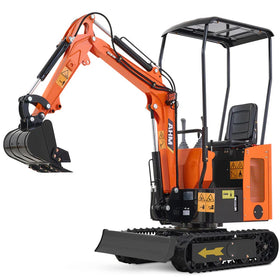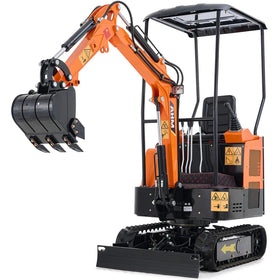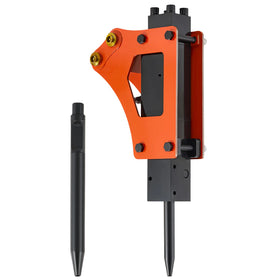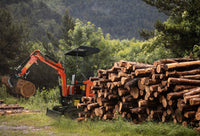Understanding excavator controls, specifically ISO vs SAE controls, doesn't have to be complicated. Just like the first time you learned to drive - what seemed overwhelming at first eventually became automatic. Excavator controls work the same way. They come in two distinct patterns, ISO (Pattern 1) and SAE (Pattern 2), and once you grasp the basic movements, operating them becomes second nature.
Let's break down exactly how these patterns work and why the differences matter for your daily operation.
What Makes ISO and SAE Controls Different
At their core, both ISO and SAE control patterns manage the same four main movements: boom, stick, bucket, and swing. The key difference lies in how these movements are split between your left and right hands.
ISO Controls: The Modern Standard
ISO controls, sometimes called "excavator pattern" or "CAT pattern," arrange movements to mirror your natural arm motion.

When you pull the left joystick back, the stick (also called dipper) moves toward you - just like pulling your arm back. This natural mapping makes ISO particularly intuitive for new operators.

ISO Left Joystick Actions:
- Pull back: Brings the stick closer (like pulling something toward you)
- Push forward: Extends the stick away (like reaching for something)
- Move left/right: Swings the upper structure in that direction
ISO Right Joystick Actions:
- Pull back: Raises the boom (lifts the arm up)
- Push forward: Lowers the boom (brings the arm down)
- Move left: Curls bucket in (like scooping)
- Move right: Dumps bucket (like pouring)
SAE Controls: The Traditional Choice
SAE controls, often called "backhoe pattern," take a different approach which is standardized in J1914. You can say it's the opposite way of operating an excavator than ISO controls.
They split the movements between hands in a way that made sense for early backhoe operators who needed to coordinate with front loader controls.
SAE Left Joystick Actions:
- Pull back: Raises the boom (lifts the arm up)
- Push forward: Lowers the boom (brings the arm down)
- Move left/right: Swings the upper structure in that direction
SAE Right Joystick Actions:
- Pull back: Brings the stick closer
- Push forward: Extends the stick away
- Move left: Curls bucket in
- Move right: Dumps bucket
Why Control Patterns Matter for Productivity

The choice between ISO and SAE is about personal preference, and it can also significantly impact your work efficiency. Here is why:
Muscle Memory and Fatigue
With ISO controls, the natural arm-like movements mean less mental translation between what you want to do and which control to move.
This can reduce operator fatigue during long shifts because your brain isn't constantly having to "translate" desired movements into control inputs.
Multi-Function Operations
Experienced operators often combine movements for smoother operation.
For example, when digging a trench, you might simultaneously raise the boom while curling the bucket. The control pattern affects how intuitive these combined movements feel.
With ISO controls, these combinations often feel more natural because they match how your arms would move if you were digging by hand.
ISO vs SAE Controls, Which to Choose for Your Operation

Previous Experience
If you've spent years operating with one pattern, switching to another might temporarily reduce your productivity.
This is why it's important to consider your experience level and comfort with each pattern when choosing equipment. Some operators stick with their familiar pattern throughout their career, while others adapt to working with both.
Type of Work
For precision work in tight spaces, some operators find ISO controls provide better fine control because the movement mapping is more intuitive. The choice often depends on the specific demands of your job site and the type of tasks you regularly perform.
Before purchasing or operating any mini excavator, it's always best to:
- Check with the manufacturer or dealer about available control patterns
- Review the operator's manual for specific control configuration options
- Consider your own experience and comfort level with different control patterns
Training Environment
If you're training new operators, ISO pattern generally offers a shorter learning curve because of its natural movement mapping.
This can reduce training time and get new operators productive more quickly.
Practical Tips for Both Patterns
Regardless of which pattern you use, these tips will help improve your operation:
1. Practice Basic Movements First
Before attempting complex operations, master single movements:
- Boom control: Practice smooth lifting and lowering
- Stick control: Work on precise extension and retraction
- Bucket control: Focus on consistent curl and dump angles
- Swing control: Develop smooth left and right transitions
2. Start Slow and Build Speed
Begin with slow, deliberate movements to build muscle memory. Speed comes naturally with practice, but accuracy must be learned from the start.
3. Use Reference Points
Whether using ISO or SAE controls, pick visual references in your work area to help gauge movements until they become second nature.
This is especially helpful when learning swing control, which remains the same in both patterns.
Frequently Asked Questions About Excavator Controls
1. What's the difference between an excavator pattern and backhoe pattern?
Think of this like learning to drive in different countries. ISO (excavator pattern) and SAE (backhoe pattern) are just different "languages" for controlling your machine. ISO pattern is more common worldwide and mirrors natural arm movements, while SAE pattern was developed in North America and feels more natural to experienced backhoe operators.
2. How do I perform a basic digging cycle with excavator controls?
A smooth digging cycle combines several movements into one fluid motion. Here's how it works:
- Start with your bucket and stick extended, positioned about a foot above your dig point
- Lower your boom while moving your bucket teeth downward
- As the bucket penetrates the soil, curl it inward while pulling the stick toward you
- Once full, lift the boom while curling the bucket to keep material from spilling
- Swing to your dump point, keeping the bucket high enough to clear any obstacles
- Uncurl the bucket smoothly to release material
In ISO controls, this feels like scooping with your hands - your left hand (stick) pulls toward you while your right hand (bucket and boom) lifts and curls. With SAE controls, your left hand manages the lifting while your right hand handles the pulling and curling motions.
3. Which control pattern is easier to learn for beginners?
Most instructors recommend starting with ISO controls if you're new to excavators. The movements match how your arms naturally work - when you want to bring something closer, you pull the left stick toward you, just like you would with your actual arm. However, the "easier" pattern often depends on your previous equipment experience.
4. Can I switch between ISO and SAE patterns?
This depends entirely on your excavator's capabilities. Before assuming you can switch patterns, always check your operator's manual or consult with your dealer about your specific model's features. Some mini excavators offer pattern switching while mini diggers are fixed in one configuration.
5. What's the most common mistake when learning excavator controls?
The biggest challenge usually isn't the controls themselves - it's trying to do too much too quickly. Start with single movements: just boom, just stick, just bucket. Once these become automatic, begin combining them. It’s best that you practice each hand separately before trying to play them together.
Conclusion: Taking Your Next Steps with Mini Excavator Operation

Understanding excavator controls is your foundation for safe, efficient operation. The most important thing is to take your time learning these controls. Good operating habits start with understanding the basics and building from there. With practice, you'll find yourself handling your machine with the kind of precision and efficiency that makes difficult jobs look easy.
If you want to expand your mini excavator knowledge, check out our comprehensive guides on "How to Operate a Mini Excavator in Tight Space" for detailed insights into operational techniques and "Mini Excavator Safe Operation Guide" for essential safety practices that every operator should know.
These resources will help you build on the control fundamentals we've covered here and develop into a more confident, capable operator.







